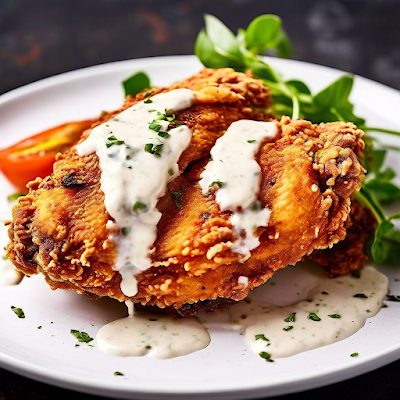Chicken-fried chicken is a quintessential Southern dish that combines the crispy texture of fried chicken with the tender juiciness of a boneless cutlet. This culinary delight offers a harmonious blend of flavors and textures, making it a favorite comfort food across many households. In this guide, we delve deep into the art of preparing the perfect chicken-fried chicken, ensuring each bite is a testament to Southern culinary tradition.
Understanding Chicken-Fried Chicken
| Click for FREE e-Book..
Definition and Origin
Chicken-fried chicken involves breading and frying boneless chicken pieces, typically breasts or thighs, to achieve a golden, crispy exterior while maintaining a moist interior. This dish draws inspiration from chicken-fried steak, where a similar method is applied to beef. The term "chicken-fried" denotes the style of preparation rather than the protein used.
Distinguishing from Traditional Fried Chicken
Traditional fried chicken usually consists of bone-in pieces that are marinated, battered, and deep-fried. In contrast, chicken-fried chicken utilizes boneless cuts, flattened for even cooking, and is often shallow-fried. This method allows for a quicker cooking process, making it ideal for weeknight dinners.
Essential Ingredients
To embark on crafting the perfect chicken-fried chicken, gather the following ingredients:
- Boneless, Skinless Chicken Breasts or Thighs: Opt for pieces approximately 6 ounces each. Thighs offer a richer flavor, while breasts provide a leaner option.
- Buttermilk: Acts as a tenderizing agent and imparts a subtle tanginess to the chicken.
- Pickle Juice: Enhances flavor complexity and further tenderizes the meat.
- Eggs: Serve as a binding component in the breading process.
- All-Purpose Flour: Forms the base of the breading mixture.
- Seasoned Salt and Black Pepper: Fundamental seasonings for depth of flavor.
- Cayenne Pepper: Adds a hint of heat, adjustable to preference.
- Baking Powder: Introduced to the flour mixture to achieve a lighter, crispier crust.
- Saltine Crackers: Crushed and combined with flour for an extra crunchy texture.
- Peanut or Vegetable Oil: Suitable for frying due to high smoke points.
- Whole Milk: Essential for crafting the accompanying gravy.
- Butter: Provides richness to the gravy.
Step-by-Step Preparation
1. Marinating the Chicken
Begin by preparing the marinade to infuse the chicken with flavor and tenderness.
- Combine Liquids: In a medium bowl, whisk together 1 cup of buttermilk, 1/4 cup of pickle juice, and one large egg until smooth.
- Marinate: Submerge the chicken pieces in the mixture, ensuring full coverage. Cover and refrigerate for at least 30 minutes, or up to 4 hours for enhanced flavor.
2. Preparing the Breading Station
Organize a systematic breading setup to ensure efficiency and consistency.
- Dry Mixture: In a shallow dish, combine 1.5 cups of self-rising flour, 1 tablespoon of seasoned salt, 2 teaspoons of ground black pepper, and 1/4 teaspoon of cayenne pepper. Mix thoroughly.
- Wet Mixture: In another shallow dish, whisk together 1.5 cups of buttermilk and two large eggs until well blended.
3. Breading the Chicken
Achieving the ideal crust requires a meticulous breading process.
- First Dredge: Remove a piece of chicken from the marinade, allowing excess liquid to drip off. Dredge it in the dry mixture, pressing lightly to ensure adherence.
- Buttermilk Dip: Submerge the floured chicken into the wet mixture, coating it evenly.
- Second Dredge: Return the chicken to the dry mixture for a final coating, ensuring a thorough and even layer.
4. Frying the Chicken
Proper frying technique is crucial for a crispy exterior and juicy interior.
- Heating the Oil: In a large cast-iron skillet or Dutch oven, pour oil to a depth of approximately 1.5 inches. Heat over medium-high heat until the oil reaches 350°F (175°C).
- Frying Process: Carefully place the breaded chicken into the hot oil, frying in batches to avoid overcrowding. Cook for 3-4 minutes per side, or until golden brown and the internal temperature reaches 165°F (74°C).
- Draining: Transfer the fried chicken to a wire rack set over a baking sheet to drain excess oil. Keep warm in a preheated oven at 200°F (93°C) while frying remaining batches.
5. Crafting the Creamy Gravy
No chicken-fried chicken is complete without a luscious gravy to complement it.
- Preparing the Roux: In a clean skillet, melt 1/4 cup of salted butter over medium heat. Sprinkle in 1/3 cup of all-purpose flour, whisking constantly, and cook until the mixture turns light golden brown, approximately 2 minutes.
- Incorporating Milk: Gradually add 3 cups of warm whole milk, continuing to whisk to prevent lumps. Season with 3/4 teaspoon of salt and 1/2 teaspoon of ground black pepper. Bring to a gentle simmer and cook until the gravy thickens, about 3 minutes. Adjust seasoning to taste.
Serving Suggestions
To create a well-rounded meal, consider pairing chicken-fried chicken with classic Southern sides:
- Mashed Potatoes: Creamy and buttery, they serve as an excellent base for extra gravy.
- Buttermilk Biscuits: Fluffy and warm, perfect for sopping up any remaining sauce.
- Green Beans: Lightly sautéed or steamed, they add a fresh, crisp element to the plate.
- Coleslaw: Provides a tangy crunch that balances the richness of the fried chicken.
Tips for Success
- Uniform Thickness: Ensure chicken pieces are of uniform thickness, approximately 1/4 inch, to promote even cooking.
- Oil Temperature Maintenance: Use a thermometer to monitor oil temperature, keeping it between



0 Comments